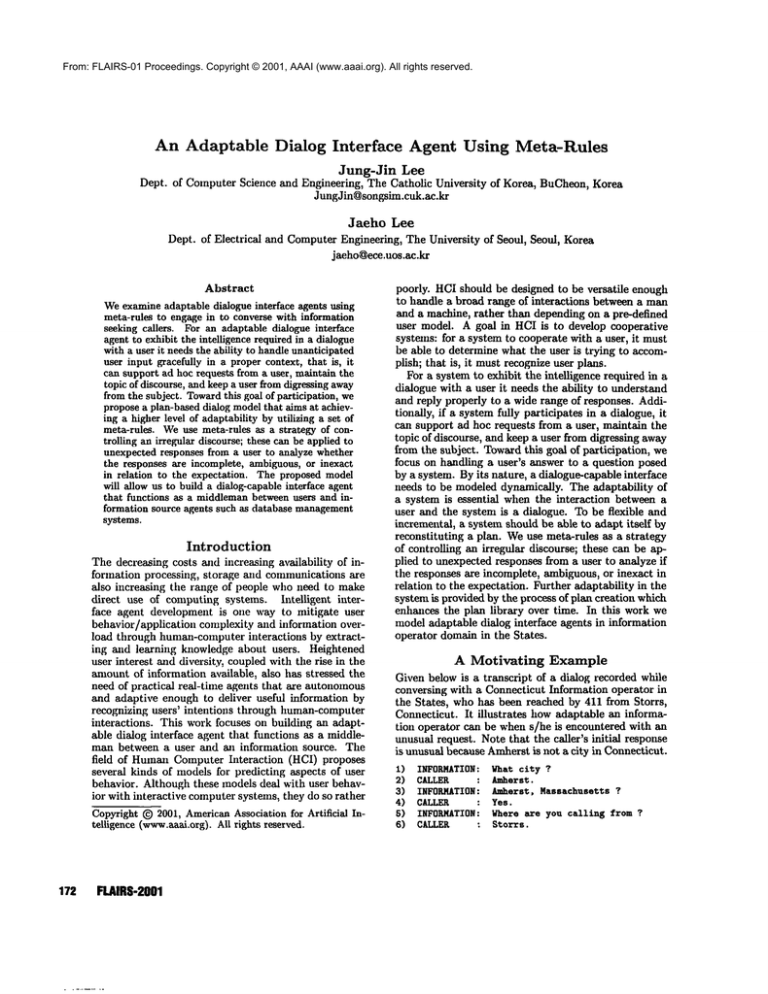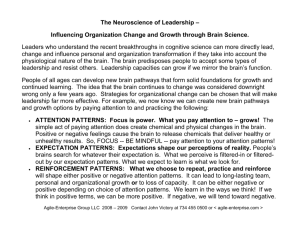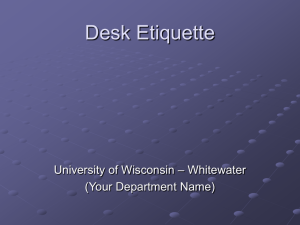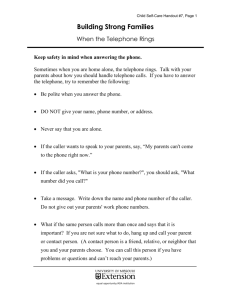
From: FLAIRS-01 Proceedings. Copyright © 2001, AAAI (www.aaai.org). All rights reserved.
An Adaptable
Dialog
Interface
Agent Using Meta-Rules
Jung-Jin Lee
Dept. of Computer Science and Engineering, The Catholic University of Korea, BuCheon, Korea
JungJin@songsim.cuk.ac.kr
Jaeho Lee
Dept. of Electrical
and Computer Engineering, The University of Seoul, Seoul, Korea
jacho@ece.uos.ac.kr
Abstract
Weexamineadaptable dialogue interface agents using
meta-rules to engage in to converse with information
seeking callers. For an adaptable dialogue interface
agent to exhibit the intelligence required in a dialogue
with a user it needs the ability to handleunanticipated
user input gracefully in a proper context, that is, it
can support ad hoc requests from a user, maintain the
topic of discourse, and keep a user from digressing away
from the subject. Towardthis goal of participation, we
propose a plan-based dialog modelthat aims at achieving a higher level of adaptability by utilizing a set of
meta-rules. ~re use meta-rules as a strategy of controlling an irregular discourse; these can be applied to
unexpected responses from a user to analyze whether
the responses are incomplete, ambiguous, or inexact
in relation to the expectation. The proposed model
will allow us to build a dialog-capable interface agent
that functions as a middlemanbetween users and information source agents such as database management
systems.
Introduction
The decreasing costs and increasing availability of information processing, storage and communications are
also increasing the range of people who need to make
direct use of computing systems. Intelligent
interface agent development is one way to mitigate user
behavior/application complexity and information overload through human-computer interactions by extracting and learning knowledge about users. Heightened
user interest and diversity, coupled with the rise in the
anmunt of information available, also has stressed the
need of practical reai=time agents that are autonomous
and adaptive enough to deliver useful information by
recognizing users’ intentioils through human-computer
interactions.
This work focuses on building an adaptable dialog interface agent that functions as a middleman between a user and a~l information source. The
field of HumanComputer Interaction (HCI) proposes
several kinds of models for predicting aspects of user
behavior. Although these models deal with user behavior with interactive computer systems, they do so rather
Copyright (~ 2001, AmericanAssociation for Artificial Intelligence (www.aaai.org).All rights reserved.
172
FLAIRS-2001
poorly. HCI should be designed to be versatile enough
to handle a broad range of interactions between a man
and a machine, rather than depending on a pre-defined
user model. A goal in HCI is to develop cooperative
systems: for a system to cooperate with a user, it must
be able to determine what the user is trying to accomplish; that is, it must recognize user plans.
For a system to exhibit the intelligence required in a
dialogue with a user it needs the ability to understand
and reply properly to a wide range of responses. Additionally, if a systemfully participates in a dialogue, it
can support ad hoc requests from a user, maintain the
topic of discourse, and keep a user from digressing away
from the subject. Towardthis goal of participation, we
focus on handling a user’s answer to a question posed
by a system. By its nature, a dialogue-capable interface
needs to be modeled dynamically. The adaptability of
a system is essential when the interaction between a
user and the system is a dialogue. To be flexible and
incremental, a system should be able to adapt itself by
reconstituting a plan. Weuse meta-rules as a strategy
of controlling an irregular discourse; these can be applied to unexpected responses from a user to analyze if
the responses are incomplete, ambiguous, or inexact in
relation to the expectation. Further adaptability in the
system is provided by the process of plan creation which
enhances the plan library over time. In this work we
model adaptable dialog interface agents in information
operator domain in the States.
A Motivating
Example
Given below is a transcript of a dialog recorded while
conversing with a Connecticut Information operator in
the States, who has been reached by 411 from Storrs,
Connecticut. It illustrates
how adaptable an information operator can be when s/he is encountered with an
unusual request. Note that the caller’s initial response
is unusual because Amherstis not a city in Connecticut.
1)
2)
3)
4)
5)
6)
INFORMATION:
What city ?
CALLER : Amherst.
INFORMATION:
Amherst,
Massachusetts
7
CALLER
: Yes.
INFORMATION:
Whereare you callingfrom ?
CALLER
: Storrs.
7)
8)
9)
INFORMATION:
Storrs, Connecticut ?
CALLER : Yes.
INFORMATION:
You must dial 1-413-555-1212
In item 1, the system initiates a dialogue with a default plan, while expecting a city nauru a~nong169 cities
in Connecticut. If the response fulfills the expectation,
then it continues the plan.
In item 2, tile response results in Unsuccessful Expectation Fulfilhnent because the city Amherst is not
in CT. the system invokes nmta-rules to handle the failure by trying to determine what plan the user is trying
to follow.
ill item 3, the system determines (via information in
its database) that there is an Anflmrst in Massachusetts,
a~ul that it knows a plan for getting telephone inforInation in Massachusetts (from its plan library). PIUM
hypothesizes the user’s reply and attempts to get a confirmation froIn a user with "Amherst, MA?", using the
HYPOTHESIZErecta-rule.
In item 4, when tile hypothesized intention of a user
is colffirmed with a user’s reply, the action part of the
nmta-rule is activated. While PIUMis searching for
an applicable plan for current situation from a plan library as ml action part of the meta-rule, the result of
retrieving a plan library showsthat there are two different plans available depending ut)ou whether the target’s
area is equal to the caller’s area.
In item 5, a new query IW PIUMis created and asked
to knowa caller’s location for clarifying between two
plans. The system recognizes that additional information is needed, the current plan is modified by adding
new query and this modified plan will be stored as a
new plan. With this l)lan creation, the system then
learns and is enforced for the future adaptation.
In item 6, when PIUMreceives "Storrs.. CT", it decides that OUT-OF-STATEinformation request plml
is suitable over LOCAL
information request plan.
In item 7, PlUMconcludes the case by responding
with the data retrieved from the database for ml area
code of Amherst.
This work focuses on proposing a model that can account for generating the system’s subsequent actions in
proper context once specific expectation-response relationship type is identified.
The Model
Limitations of the knowledgebase is an important problem in AI, for example, having a closed world or an
open world model. However, considering the problems
in both of these nmdels [1], leads to the point that the
ideal system needs to combine the best of both. Based
on this idea, PIUM uses an open world model as it
serves, while it staxts with a closed world model.
Whena system does not have complete information
about a~ area, an expectation failure will likely occur
during a dialogue. The ideal system needs to handle
the expectation failure based on the extent and limit of
available knowledge, what facts are relevant ill a given
situation, how dependable they are, and how they are
to be use. This supports the use of meta-rules.
Task-Oriented
Plans
An important premise of the proposed model is that one
can identify a set of task-oriented plans that are specific to certain routine tasks. Each task-oriented plan is
a description of a sequence of actions or subtasks that
the agent should carry out to achieve a certain goal.
PIUMstarts with an initial set of three task-oriented
plans. Without having a rich set of user models, it is
guided by knowing where it lacks knowledge and where
a user has a misunderstanding. As an initiative interface agent, PIUMinitiates a dialogue with a default
plan instead of waiting for a user to submit a request.
The users ca~l benefit from the guidance of the system
which draws the relevant ra~lge of a task-oriented plan
in a domain. The plmmare used to synthesize an instance of a task- oriented plan. Each different interaction is renmmbered. Each plan related to the instance
is also renmmberedfor future adaptation.
Figure 1 includes two plans that are designed to
model two different dialog patterns which an information operator might typically engage in to converse with
information seeking callers. Plan Onelists four subactions that can be considered prescribe the information
operator’s most commonactivities. It thus constitutes
the default plan. Plan Twoaccounts for the case where
the caller is requesting the target’s numberthat exists
outside of the caller’s resident state. In this case, the
information operator usually refers the caller to the information operator of the target’s state.
Onenovel feature included in the plan given in Figure
1 is that each system’s question specified in each step is
accompanied by an expectation. Each expectation describes the nature of potential answers to the pending
question. Problematic cases occur when the responses
does not match, either directly or indirectly, the expectation. The idea proposed in this work is to use a set
of meta-rules to handle these problematic cases.
Meta Rules
PIUMuses meta rules as control knowledge to help it
decide the next plan to be followed and lead a user’s responses to get the final goal given an irregular request.
In PLUM,meta rules are primarily used in dealing with
a system’s expectation failures. These meta rules are
utilized to infer applicable plans and, if necessary, plan
creation. We assume the following scenario and notations. The system is equipped with a set of taskoriented plans, denoted by Pl, P2, ---- At one point,
the system asks a question to the user following what
has been prescribed in the j~h action A~ of some plan
PC.. The expectation accompanying A~ is denoted by
Ej. Oncethe user response, denoted by I, is input, the
system compares I against E~ to determine the relationship between I and E~.
Each meta~rule
is a triple
<IF, THEN,
SUBSEQUENT-ACTION
(SA)>,
where the IF
HCl / IUI 173
~AULTPI~LN (Pla=-One)
Ass~tlon : The caller,s
tawpt resides at Com~ectlcut.
Actioa-1
Goal :
Get the city ~mevhere the t~rpt resides,
CDB: Spac~
the ctty-diractoz7 relation]
ASK:
What city7 ?
EXPECT: A city name ~ 16g C~=aecttcut cities.
Actl¢=-2
aosl :
Get the tsrgetss Identifier.
~B: Specify the nlectt~ coDditt~ 2or name]
ASK:
Yea ?
ZXPEG’r
: £ name o2 a pers~ or a busluess.
I does not match Ej, and
I partially matches E~ ofP~, k <> c,
THEN
hypothesize a switch to the plan P, and
verify whether I can match E~ completely.
SA
if verification is positive, switch fromPc to
P~; otherwise, invalidate the plan switch.
IF
ACti~-3
Ooal :
Uetrteve the tmr~et’s phone at~ber fr~ DB,
act/ms
~I~IEVE phase P ~q
.~clty-gL~recto~y
~ ~ i T titrKot
PboDeisttmber(s) for the target
Here is an example of hypothesizing intention using
above meta rule.
lcti~-4
GO&I:
Provide the t~t~s tele~sone amber
~SPOR9
: Al(SWn(DB ¯CrI01/)
CALLER
: Amherst
INFOP~qATION : Amherst, HA T
PLAN- Tvo: Seekiug 0ut-of-State ]fnfo. Operator
Assu~ption : The caller’s ts:Set rsslees at C~ecticut.
While the system expects a city name in Connecticut, and the user responds ’Amherst’, wlfich is not a
city in Connecticut: the system finds possible information by retrieving from the database. Whenthe information is derived from the database, not given by the
user, the system needs to confirm the hypothesis with
the user. In this case, the system hypothesizes that
Amherst refers to Amherst, MA.
M~2. Choose one from multiple applicable plans:
There could be cases when the input matches directly
or indirectly multiple expectations specified in steps of
different plans. In this case, the system needs to construct a counter question whose answer could discern
a particular
plan among many applicable ones. The
method of computing the counter question is based on
differences in assumptions of the matching plans.
Act/~-I
~oal :
ASX:
5st the clty ~ vhere the tax’Kit L’esidss.
[DE: Speclfy the city-dl~moto~ z~latlo~
~rnat city and state ?
Nol%-~rcity nTtlS~ Mzdits state Dame
Actl(m-2
5oal :
Retrieve the tL1~gel;~s a~ea code fr~ 5B.
[DB: Specify the selection coneltl~ for name]
DIS ACT: IU~RZEV~
e.-’ea-code l~ON
?state-directory
~ city-lame - ? target
JLrea-coda fo~ <city-nm, state-Dame)
¯crieD-0
5oal :
Provide the a~ea-code~md555-1212
~ESPOND
: iU/S~ (l-Tarea-code-555-1212)
pla,~.-’~ree: Local Xdoz~atloa Reqtl~st
The ta~get~s locatlon is same
ASs~tlon:
u the callerSs state
£ctloa-I
5o&1:
5st the clty :tame in ~atcJs the caller 18 int~restad J~:.
IDa: Specify tin cl~y-diz~ctory relation]
ASK:
What city T
]L~o~l~r : ¯ City Dame
111 ~onJttnct:L~ with a state na~o.
¯CttOZ;-2
50L1 :
Provide the local Idomtlon operator
RESPOND:Dial 1-555-1212.
atusbar.
Figure 1: Plan with Expectations in Actions
part specifies the rule invoking preconditions, and the
THENpart prescribes the activity the system should
initiate
as a consequence of the rule invoking. The
SA part is a subordinate IF-THEN structure
that
describes the type of subsequent condition and action
pair the system should employ to handle the user’s
counter response to the system’s action specified in the
THENpart.
M1. Hypothesize the user’s goal and Verify: There
are cases when the user response does not satisfy the
pending expectation but may partially matches an expectation embedded in some action of a plan that is
different from the pending one. If the match to a different expectation were complete, switching to the corresponding plan could be done, provided such a switch
does not contradict any exchange that took place between the user and the system earlier. If the match is
incomplete, the plan switch cm; only be contemplated.
174
Thus the system first hypothesizes a plan switch, but
prior to actually doing so the system attempts to verify
that this is the correct action to take.
FLAIRS-2001
IF
I does not matchEcj, and
I completely matches E~ of P~, k <> c, and
I’completely matches E~ of P~, n <> c,
THENcompute and ask a question Q that can
discern E~ ... E~.
SA if the response allows to choose one among
E~ ... E~, perform the plan switch,
otherwise, invalidate the plan switch.
M3. Clarify partial matching case: There are cases
when the user response matches tim expectation partially. In this case, the system constructs a clarification
counter question. A few techniques can be employed.
One approach is to produce an argument interrogative.
Another approach is to form a yes-no m~swer choice
question. The last two approaches are possible o~dy if
the system can compute possible additional component
that can make the original response complete or unambiguous.
IF
I partially matches EJ,
THENcompute and ask a question Q whose
answer combined with I can match E~.
SA
if the response enables system to determine
a complete match, continue on with Pc,
otherwise, (no specification is needed).
M4. Rephrase the original question with additional
in]ormation: there are cases when users provide a~l information which does not satisfy the current expectation but satisfies instead an expectation associated with
one of the upcomingactions of the current plan. While
holding on to the current plan, the system needs to
repeat the original question. In doing so, instead of
merely repeating the same question, it can incorporate
the prematurely given answer in a rephrasing of the
original question.
1 does not match Ej, and
I matches E~ u > j,
THENcompute and ask a question Q that rephrases the
question specified in .4~ by incorporating I,
andindicate that E~ has beenfulfilled.
SA (no specification is needed)
IF
All example of rephrasing the unanswered question
INFORMATION : What city ?
CALLER
: The last nameis Williams,
and the firstinitialE.
for ?
INFORRATION : Whichcity is E. Williams
CALLER
: Oh, this is for BERLIN.
INFORMATION : The phonenumberis 264-8117.
Referring to tile default plan in Figure 1, PIUMinitiates a dialogue and receives a response ’E. Williams’
from a user. Since a nanm of a person or a business
is expected after a system notices a region of a caller’s
target, the system rephrases the request with tile user’s
response to get the unansweredquestion, that is, a target of the caller.
Plan Creation (as mentioned in item 4 and 5 of the
motivating example) is similar to Collins’ work [2]. In
the situation in item 4 a target’s location is in Massachusetts and a caller’s location is unkuown. This
causes a plan failure and presents a possible linkage to
plan-two or plan-three. Therefore, a new query is made
to get missing information to distinguish between two
applicable pla~ls. Based on the user’s response, if a target’s area is tile same one as the user’s area, then plan
-three will be selected, otherwise, plan-two. In order to
distinguish between plan-two mid pla~l-three, the following actions are made. Since neither plan can handle
current features alone, after the new query is created,
the actions are included in a pending plan and the inodified plan is stored ill the plml base as a newplan for
future adaptation. In this way, the system’s discourse
models are enhanced as PIUMhas more experiences.
A newly created plan including new actions following is
fundmnentally a merge of plan-two and plan-three.
lctt~-n
~al :
Oct the location of the caller.
[C~xap~rethe caller’s locatt~l vtth
the t~rgat’s location]
ASK : trnea-e aN you callin E from ?
EXPECT: ¯ city ~ in conJuncti~ with a etate
name.
Actl~-n~!
If the caller*e locatio~ ~> the ta~get~s location,
Then PL~ T~
I£ the caller*s loc~tlon - the tarset’s locatl~,
Then PLANThzee
Prototyping
and Testing
The prototype system called PIUM(Plan-based Interface Using Mete-rules) has been built. This section represents control strategy, plan representation, and meterule representation in PIUM.
Control
Strategy
As an initiative interface, PIUMopens a dialogue with
its own questions pre-stored in a default task-oriented
plan. During the matching process of a system’s expectation to a user’s response, mete-rules are invoked
to handle a current situation if an expectation failure
occurs. Handling incomplete information is pursued to
infer a more suitable plan when multiple plans are applicable to settle a current situation. It is done by identifying the crucial information needed to distinguish one
plan from the other and making a new query to obtain
the information. A new plan is created based on the
added information for later use.
Plan Representation
Eachplan contains a sequence of actions that the system should initiate to engage in a dialogue with the
caller as well as to perform related database access
tasks. Each action is madeof four parts: goal, ask, expect and done. The goal part specifies the type nameof
an identifier that is to be elicited from the user. The ask
part specifies the logical form of question that should
be presented either to the caller, or to the underlying
database. The expectation part keeps the data structure that minimally represents the nature of the expectation the system should have with respect to the question specified in the ask part. The done part will be
an indicator to show how its action is executed. This
structure is continuously modified as the system progresses.
Like most plan recognition systems, PIUMhas taskoriented plans which have a rigid temporal ordering of
actions. However,utilizing meta rules allows a flexible
temporal ordering can be. Wlmnan expectation failure
happens, PIUMcan hypothesize this situation and the
confirmation of the hypothesis from a user can bring
another plan. This demonstrates an attempt to check
the vaUdity of the pending plan once it is chosen.
Meta rule Representation
Tile representation language used for meta rules is a
predicate logic that associates predicates and events in
the Lk language form which attempts to combine the
advantages of the foundations of a formal logic with
the structural flexibility of frames [3]. A meta rule in
PIUMconsists of a representations of situations and a
handling strategy. Each meta rule includes what PIUM
knows about a current situation, how PIUMwill handle
this situation, and what PIUMknows as possible side
effects. Any aspectual of a relation among meta rules
will be constrained to be selected by a current situation. The structure of meta rules allows branching and
HCl I IUI 175
iteration. 2. In a current implementation, tile order of
meta rules are not so critical in the process of a recovery, since all meta rules are inspected. Moreover,since
each different situation has a different strategy, no conflict amongmeta rules is expected for handling a failure
case. Although the efficiency of the order of meta rules
is not so critical with limited numbersof rules at this
point, it stands to reason that checking a rephrase meta
rule is preferable in that it allows PIUMto remain in
tile same plan.
Related
Work
Our system is an initiative interface, that is, an interface that actively participates in a dialogue. The work
of PIUMencompasses the research of mainstream plan
recognition and user modeling: providing more intelligent interfaces for interactive environments.
The work by Litman and Allen [4] discuss how a plan
recognition model can account for a variety of subdialogues such as clarification,
corrections and topic
changes. The work by Lambert and Carberry [5]
presents a belief model in an attempt to identify negotiation subdialogue structures. Query clearing house
approaches as a mediator between the end users and
databases also have been done in [6][7]. None of these
work, however, deals with handling of expectations
which are inherent in argument interrogative types of
questions. The lack of addressing expectations in the
literature is due to the different nature of problem the
various work attempt to model. For example, Litman a~ld Alien aim at accounting for flow changes in
relatively general types of dialogues and thus present
a model based on domain plans and discourse plans.
Most of above work allow interaction
between Human
and Interface by weighting more focus oll inferring
user’s intention in a passive way.
The work presented here offers two-way communication by actively participating in a dialogue and addresses a narrowly focused range of communicationfailures. Specifically, it aims at designing a computational
system that is capable of handling a user’s unexpected
response to an argument interrogative type of questions
posed by the system. Allowing users to respond to
system-initiated questions in all unconstrained way entails careful analysis of relationships betweensystem expectation and user response. Regularities exist in handling expectation failures of user responses. The work
presented here is an attempt to model the regularities
in terms of meta-rules which should be applicable on
top of task-oriented plans.
Conclusion
This work focuses on building an adaptable dialog interface agent that functions as a middlexna~l betweena user
a~ld ml inforInation source. If we are not to unduly constrain the user’s input to the interface agent, the agent
should be able to handle unexpected responses from the
user in a proper context. The presented model assumes
176
FLAIRS-2001
that the system-initiated questions can originate from
a sequence of the predetermined actions embeddedin a
task-oriented plan.
However, the presence of ad hoc user responses increases uncertainty, but such uncertainty as can be recognized can be handled by asking the appropriate questions instead of performing expensive inferences. Unlike
most existing recognition approaches, each of agent’s
question is accompanied by an ’expectation’ describing
the nature of the potential answers. A set of meta~
rules has been proposed which can then be used to direct the system what to do when the response does
not completely fulfill the pending expectation. The
number of meta-rules can be vary depending on the
domain to handle more detail level and to be suitable
within broaden domains, while the meta rules are general enough to be domain-independent.
These ideas are applicable to recognition systems
that assist users in particular problem domains, where
the system has more (and better) information about
the problem domain than the user. It is advantageous
for a system to maintain relevance here; the goal is that
the system provide useful information without confusing the user with unnecessary details.
This work has pointed out the need for some enhancements: For one, we need a richer representation language to be able to handle more complicated situations
and plans. Additionally, we need a more robust way
of inferring the closest plan, as the number of plans
increases.
Acknowledgment
We thank to Dr. Dong-Guk Shin at the University of
Connecticut for his insight and advise on this work.
This work was supported by the Catholic University
Settlement Research Fund Granted in the Program
Year of 2001 and by the KOSEFthrough the Advanced
Information Technology Research Center(AITrc).
References
[1] D. Chin. KNOME:
Modeling Whatthe User Knowsin
UNIX.In User Modelsin Dialog Systems, Springer-Verlag,
NewYork, 1989.
[2] G. Collins. Plan Creation. In Inside Case-basedReasoning. LawrenceErlbaum,1989.
[3] L~: A Languagefor Capturing Real WorldMeanings
of the Stored Data. In Proc. of the Int. Conf. on Data
Engineering,pages 738-745, Kobe,Japan,1991.
[4] D. Litmanand J. Allen. A Plan RecognitionModelfor
Subdialoguesin Conversation.In Cognitive Science, 11:163200, 1987.
[5] L. Lambertand S. Carberry.ModelingNegotiation Subdialogues. In Proe. of the 30th AnnualMeetingof the A CL.,
pages 193-200, 1992.
[6] W. Kimand J. Seo. Classifying Schematic and Data
Heterogeneity in Multidatabase Systems, IEEEComputer,
December1991.
[7] G. Wiederhold.Mediatorsin the Architectureof Future
Information Systems, IEEEComputer, pages 38-49, March
1992.






